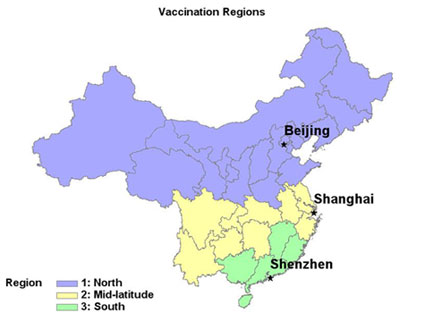Researchers suggest phased flu vaccination for China
November / December 2013 | Volume 12, Issue 6
China should tailor its influenza vaccination strategies to account for its three distinct flu regions, according to the first comprehensive study of the country's flu patterns conducted by a research team of Chinese and American scientists.

Research conducted by Fogarty and China CDC scientists identifies three
regions for influenza vaccination in China: Annual vaccination campaigns
should be initiated in October-November in northern China (blue) and in
February-March in southern China (green) to accommodate local seasonal
influenza activity. In the mid-latitude region around Shanghai (yellow),
the optimal timing of vaccination is complicated by semiannual influenza
activity and should be clarified based on further research.
Download a
full map file [<1M] for use in your publication. Please credit
"Fogarty International Center / NIH."
Flu season in northern China occurs during the same period as in the world's other northern temperate zones, but in the south the disease peaks in the spring, while patterns in a third, intermediate zone are complex and require more research, according to the study, led by Fogarty researchers. The team has been assisting the Chinese Centers for Disease Control and Prevention with flu studies for several years, including providing training to a number of Chinese scientists who have visited the NIH campus.
"This research suggests the need for staggered timing of vaccination in three broad epidemiological regions," said Dr. Cecile Viboud, who co-authored the study with Fogarty colleagues and Chinese collaborators.
The study recommends that northern China conduct annual vaccination campaigns starting in October, as is typically recommended for the Northern Hemisphere. Southernmost Chinese provinces, in contrast, would be better off vaccinating beginning in February.
The research published by
PLOS Medicine was part of the Multinational Influenza Seasonal Mortality Study (MISMS), an ongoing, Fogarty-led collaborative effort to study the epidemiology and evolution of influenza in the tropics and other parts of the globe. NIH and the Chinese CDC funded the work.
The study aimed to characterize the seasonality of the disease across China to help optimize the timing of future vaccination programs. While China introduced seasonal influenza vaccination in 1998, only about 2 percent of the population is routinely immunized. Although health workers in Beijing and a few other cities now vaccinate older adults and school-age children against flu, the country has yet to initiate a countrywide plan. It is estimated that influenza annually causes 11-18 deaths per 100,000 people in China, with underdeveloped rural areas suffering two to three times higher flu-related death rates than wealthier cities.
More research would be helpful to confirm the optimal vaccination policy, particularly for the mid-latitude provinces around Shanghai, the authors stated.
"Before a national influenza vaccination program can be established in this large, climatologically diverse country, public health experts need a clear picture of influenza seasonally across the country that could be used to optimize the timing of a future Chinese vaccination effort," Viboud said.
The study showed influenza peaked on average between late December and early January in northern China. A weaker but still significant annual peak occurred from mid-May to mid-June in the south. In mid-latitude provinces, there were semiannual peaks in January-February and again in June-August.
Study data were gathered by collecting samples from participating hospitals in cities in each of China's 30 provinces from 2005-2011. Statistical analyses enabled the researchers to designate three epidemiologically distinct flu regions.
The immunity stimulated by current flu vaccines tends to decay within four to eight months, so it is vital for people to be vaccinated in the months immediately preceding flu season, the authors noted.
The study's results were reminiscent of those of a Fogarty-led study set in Brazil, where epidemics originate in the northern equatorial states and move toward the subtropical south over a three-month period, indicating the need for staggered timing of vaccination across the country. Brazil and China have markedly different flu patterns from the United States, for example, where winter epidemics are driven by large population centers and are usually synchronized nationally.
Given the growing interest in rolling out national influenza immunization programs in low- and middle-income countries (LMICs), the authors suggest these findings highlight the importance of ensuring that vaccination strategies are optimized by taking into account local disease patterns.
More Information
To view Adobe PDF files,
download current, free accessible plug-ins from Adobe's website.